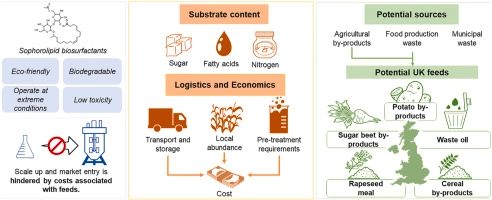A review of sophorolipid production from alternative feedstocks for the development of a localized selection strategy

The replacement of traditional petroleum-based surfactants with renewable biosurfactants is a key part of the transition towards a circular economy. Sophorolipids are the most commercially adopted biosurfactant due to the existence of high productivity fermentation process, excellent surface and interfacial tension properties and because the main producer organism Starmerella bombicola is non-pathogenic/non-GMO. However, the current large-scale production of sophorolipids still utilizes purified substrates such as glucose and oleic acid. This is a major reason their price is an order of magnitude higher than traditional surfactants, severely limiting their commercial adoption. Hence, implementation of sophorolipid production from alternative biomass byproducts and wastes is crucial. This review illustrates the potential performance of alternative feedstocks as sources of sugars, fatty acids and nitrogen for sophorolipid production. Important studies where alternative feedstocks outperformed purified substrates under the same conditions, as well as high overall production of sophorolipid using sophisticated fermentation schemes are highlighted. Promising performance such as productivities of up to 2.4 g/L/h currently exist with processes based on alternative feedstocks. Important knowledge gaps within the literature are also identified, such as the need to combine alternative feedstocks to eliminate the use of purified substrates. Future improvement of productivity on alternative feedstocks could be achieved via implementation of sophisticated fermentation schemes to either improve cell titer during growth or to improve SL production itself, such as in-situ separation of sophorolipids. Selection criteria were produced using key performance factors identified from the literature, together with other factors such as available quantity, price and logistics as well as the potential for integrated biorefining. These selection criteria were then applied to the UK as a case study. In the future, the framework developed could be applied to feedstock assessment and selection for localized sophorolipid production in various locations around the world.
Publisher URL: https://www.sciencedirect.com/science/article/pii/S0959652621029267
DOI: 10.1016/j.jclepro.2021.128727
Keeping up-to-date with research can feel impossible, with papers being published faster than you'll ever be able to read them. That's where Researcher comes in: we're simplifying discovery and making important discussions happen. With over 19,000 sources, including peer-reviewed journals, preprints, blogs, universities, podcasts and Live events across 10 research areas, you'll never miss what's important to you. It's like social media, but better. Oh, and we should mention - it's free.
Researcher displays publicly available abstracts and doesn’t host any full article content. If the content is open access, we will direct clicks from the abstracts to the publisher website and display the PDF copy on our platform. Clicks to view the full text will be directed to the publisher website, where only users with subscriptions or access through their institution are able to view the full article.


